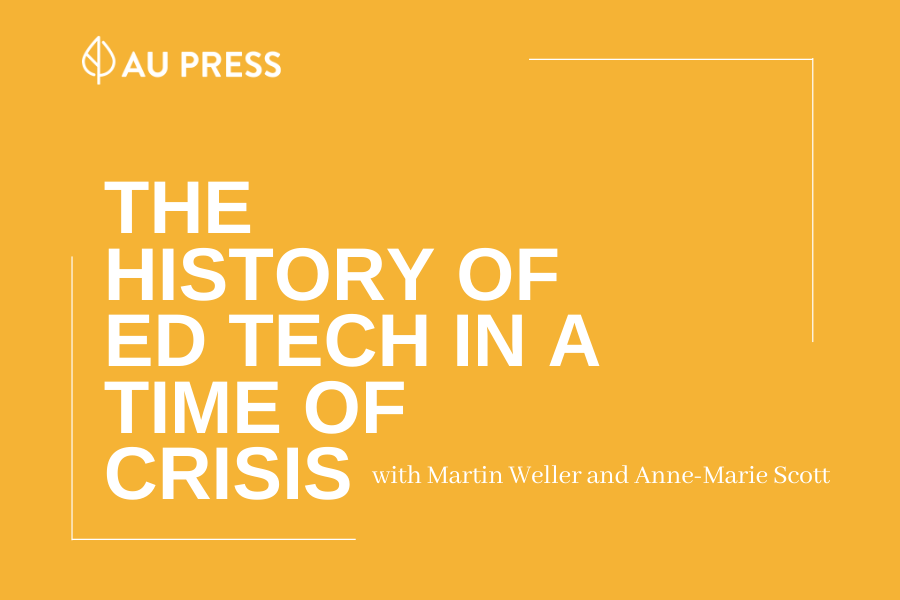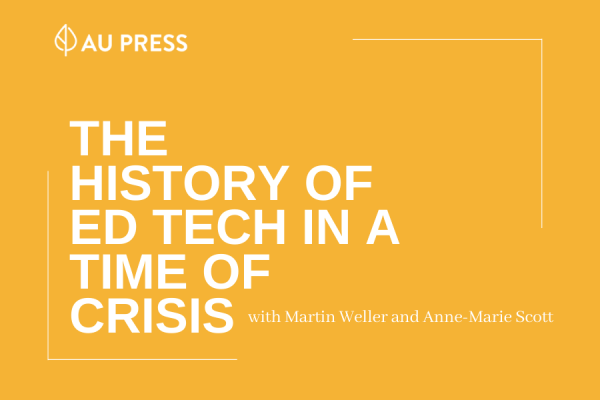The rapid pivot to online education following the COVID-19 outbreak has universities around the world leaning heavily on educational technology to facilitate remote lectures, exams, meetings, conferences, and more. But has there been enough consideration of equity, privacy, data surveillance, and disinformation? Martin Weller, author of 25 Years of Ed Tech, and Anne-Marie Scott, Deputy Provost at Athabasca University tackled some of these questions last week. Their in-depth discussion about higher education’s relationship with educational technology is available below along with some key takeaways from the presentation.
The History of Ed Tech
25 Years of Ed Tech is based on Martin’s blog series that he wrote throughout 2018. Martin notes that he turned the series into a book partly because “there’s a ‘year zero’ mentality in ed tech, a historical amnesia. That’s not an accident. If you want to sell people stuff, tell them it has never been done before. That creates a much more exciting narrative. I wanted to demonstrate that there’s an alternative narrative to that because innovation has gone on in higher education.”
Weller points out that “part of the richness of ed tech as a field, a discipline, topic, is that people come into it from different areas. But one of the downsides is that people don’t have a shared framework for talking about ed tech. I wanted to provide a basis of the recent history for people to understand.”
The Crisis
Scott notes that as we respond to the challenges presented by COVID-19, “it’s more important than ever to learn from the past but we’re all struggling with how to digest some of this history in a hurry.” She points out that “we’re all suffering from information overload as well as trying to handle the reality of our lives. How do we learn these lessons quickly and succinctly and across the board?”
Responding to the Crisis: Key Takeaways
Read 25 Years of Ed Tech.
Find the knowledge within your institution. Weller argues for listening to the ed tech structural designers in your own institutions. “There are going to be lots of pockets of expertise within any institution and those are the people you want to have in the room when the ed tech vendors come calling.”
He also notes that universities should be making decisions that persist into the future. Weller sympathizes with senior management in universities in this moment. They have to deal with an awful lot and they just want to find the magic button that will just make online learning happen. Weller argues that there’s danger in the magic button approach. “There are going to be a lot of companies coming along saying ‘we can make it happen for you. We have the magic button and it’s going to cost you X.’ And that’s quite an appealing thing but what they give you is not really what you need to be doing and you’re just creating problems for yourself further down the line because you’re not investing in staff who need to develop that expertise.” Scott agrees and notes that the magic button approach is counter to what we know even about technology change where technology is one piece, but culture change, people change, and process change all happen in tandem.
Orient your students. Scott notes that she sees a lot of emphasis (rightly) on supporting staff to transition to remote learning and teaching. However, she sees less emphasis on building intentional supports for students to transition into online learning. How important is it to help orient students and set their expectations in this moment? Scott notes that we need to help students understand that what they are about to do still has value.
Weller agrees and notes that Clint Lalonde has put together a list of resources on this topic. You can find them here. Weller considers the difference in infrastructure for on-campus and distance learning: “when you go to a campus university, the architecture, the physical buildings, do a lot of work for you. You turn up to a lecture at a certain time and receive your content. You go to another building, the library, to get your resources. When you work online with distance students, they have to take on a lot of that responsibility. They have to study asynchronously, which is a real benefit, but they have to organize class time around other competing pressures. They can decide when they want to learn and what’s best for them but that responsibility for organizing your time, getting feedback, and making connections with other students falls on the individual student and can be difficult.” Weller notes that this will be frustrating for many students. “Students who choose to study distance education really like distance education. Students who choose to study on campus like being on campus. Your perception of quality is framed by your preferences.”
Re-centre your teachers. One of the myths about online learning is that it is less resource intensive and you need fewer teachers. Weller notes that we see this with MOOCs, the idea that “we just need to shoot a talking head and a thousand people can study it. But for any of this to work, you need human support. We have graphs of how much it costs to make an Open University course and the biggest chunk is the tutor support for students, the human part. That’s the part that really matters.” Scott notes that the work coming out of the Near Future Teaching Project is really interesting right now. They’re thinking about the role of the teacher centrally within this technology space and saying these things can live harmoniously together.
Consider trust. Scott notes that she has been thinking a lot about trust recently. “There are a lot of discussions about online proctoring, but there’s also quite a lot of discussion about what it means to be a remote workforce. There’s something about the extent to which we trust each another and this moment is shining a light on a lot of these tensions and pressures which have been there just below the surface. They’re becoming really visible to our students and we’ve seen a lot of students pushing back against proctoring, against surveillance.”
Scott notes that “we often start from a default position of not trusting our students. ‘If we do not verify in an immutable way that you are who you are and you’ve done this work, then we don’t trust you.’ And a lot of the research shows us plagiarism happens when students feel that they are being asked to do something unfair or the stakes for failure are so high that they’re willing to flex their moral judgement. Right now, in this moment where we demonstrably don’t trust them and we’re asking them to do high stakes time-bound assessments and not recognizing the life circumstances that they have, all the evidence suggests that we’re probably causing a problem in this time and not helping.”
Use what you have—the LMS. Scott notes that “even the most out there ed techs are falling back on the institutional LMS because it’s designed for scale. People understand what it is with minimal amounts of training. We can see how we can use this immediately, quickly, and get to where we need to get to.”
Weller notes that this is where understanding the history of ed tech comes in handy. “You can do most of what you need to do on the LMS. You might need some more servers or support staff but you’ve already got this technology that can do most of what you need to do and you can do quite innovative things. However, in order for it to be good, you need to invest and get people to understand online pedagogy and how to get students to work effectively. The other thing you would want to put in place is understanding what you can do beyond the LMS and that’s something you can learn from understanding the history.”
Build study strategies. Weller makes the point in 25 Years of Ed Tech that there’s a rich history of ed tech innovation from within universities. Scott comments that “arguably what we’re doing now is an exercise in scaling up, which none of these MOOC platforms have ever done before. What are we learning from that?”
Weller answers that “what MOOC platforms are missing is the ability to scale up support—learning how to support students at a distance and having the people in place who have the skills to do that. Shuffling content at people only gets you so far. The people who tend to succeed are the people are the people who tend to succeed and they would do it in any environment. It’s the other students you have to worry about.”
Scott notes that the research done at the University of Edinburgh around lecture recording shows that the students who were making the best use of lecture recordings were the ones who had good study skills already as opposed to the ones who were just binge watching and didn’t have great study strategies. The problem wasn’t the technology or the recordings, it was the study skills.
These comments have been condensed for clarity. For the full discussion, check out the recording on YouTube.
![[book cover] 25 Years of EdTech Book](https://www.aupress.ca/app/uploads/120290_25-Years-of-EdTech-Book-cover.jpg)
You can download 25 Years of Ed Tech for free from our website.


